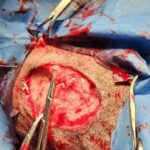Contact Us!
Mass Removals/Excisions
Animal Doctor provides mass removals/Excisions FOR CANINES AND FELINES. We accept referrals and provide second opinions.
Description: As pets age, masses can appear and grow on or under the skin, anywhere on the body.
Symptoms: Any new mass should be evaluated, and especially if there is sudden growth, a change in texture, hair loss over the top of the mass, redness and inflammation associated with the mass, or discharge is present.
How does it happen? As pets age, cells and cell growth rates change, which can lead to growth of skin and subcutaneous masses (benign or malignant). Some breeds are also at an increased risk of masses (such as Golden Retrievers, Boxers).




What questions do we ask?
- Where is the mass/swelling?
- Describe any changes that you have noticed over time?
- When did you first notice it?
- Has the mass ever been evaluated? If so, was an FNA (Fine Needle Aspirite) or histopathology performed?
- Any recent changes in Appetite/ Thirst/ urination?
- Any recent history of vomiting or diarrhea?
- Any changes in activity level?
- (Cats only) How often does your cat go outside? Does he/ she go outside on a leash or on a screened in porch?
- Is the patient on any medications? Include dosage and frequency.
What are the steps we take to treat your pet?
- Fine needle aspirate: We insert a needle into the mass and retrieve cells to evaluate under the microscope. Some masses provide diagnostic samples, but some masses do not.
- Biopsy: If the fine needle aspirate is not diagnostic, we recommend a biopsy of the mass when possible. This involves either local or general anesthesia, and excising a 3mm to 6mm sample of tissue that is submitted to an outside laboratory.
Animal Doctor Mass Removals/Excisions potential treatment plans?
Surgical Excision
- If indicated by testing, or based on the location or size of the mass, surgical excision is often recommended. This is most often completed under general anesthesia. The mass is then submitted to an outside laboratory for testing.
Oral medications
- Sometimes antibiotics, anti-inflammatories (Meloxicam, Onsior), steroids (Prednisone), or chemotherapeutic (Palladia) medications are prescribed.
Continued monitoring for concerning changes in the mass and address when appropriate.
What results have we seen?
The results of surgical excision of any mass is dependent on the location, size and type of mass, and the patient’s current condition. Many masses can be completely excised with good, tumor free margins. Some masses can only be debulked (made smaller) based on their location (limited tissue) and the type of mass. Malignant (cancerous) masses will have a different outcome to benign (noncancerous) masses. Often follow up testing, rechecks, and treatments are needed.
What are the risks if masses are left unmanaged?
A mass can continue to grow locally (the area around the mass itself) or it can metastasize (spread) based on the type of malignant mass present. Masses can interfere with locomotion, can become infected or necrotic, and can significantly decrease the quality of life of your pet. Some masses can actually lead to death.
Animal Doctor Provider
All our doctors have experience excising masses and we would be happy to schedule you an exam to evaluate your pet’s masses.



